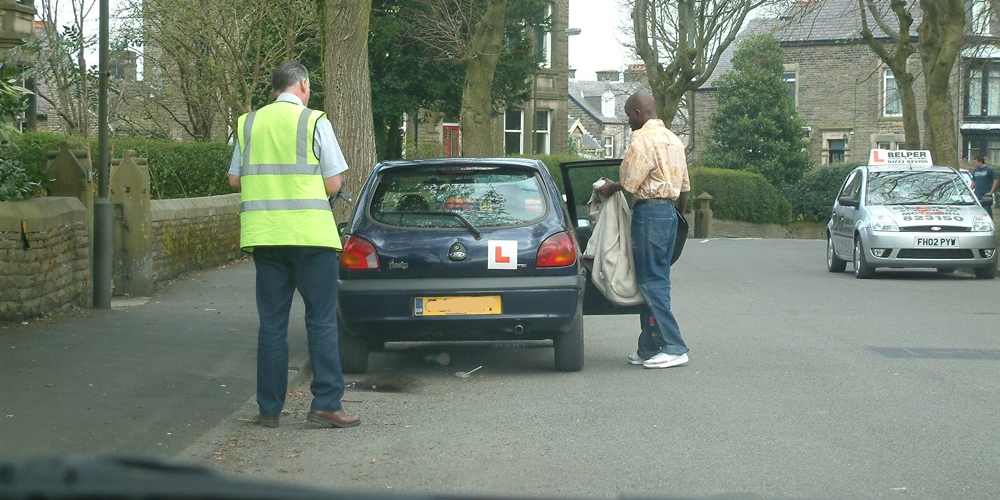
Vehicle safety check questions help to ensure that all test candidates understand basic car care and can operate all the vehicle controls. The questions are often described as "Show me, tell me" questions.
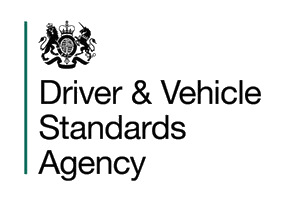 You will find all the questions and the two official videos in this lesson.
You will find all the questions and the two official videos in this lesson.
You don't have to be a mechanic to drive a car - but there are some critical safety areas that you must be aware of to ensure that you remain safe and within the law.
The items covered are those you will usually do in daily or weekly vehicle checks or everyday driving. We have added some additional information to help you to understand the reasoning behind the questions
The examiner will ask:
One 'tell me' question at the start of your test, before you start driving
One 'show me' question while you're driving
You will not fail your test if you answer these questions incorrectly (but you will be marked with one error). However, the test is not the real reason for learning this stuff.
Not knowing this information after you have passed could lead to fines, unnecessary vehicle maintenance costs, or an accident in the worst-case scenario.
Things the examiner will be assessing:
The accuracy of your answers
Your understanding of the relevant information
Your safety awareness when completing the checks
Note: There is no quiz for this lesson.
This the Official DVSA 'Tell Me' Video...
For these questions, you don't have to demonstrate the action. You just have to explain how you would do it.
However, the examiner might ask you to open the bonnet and point out various fluid reservoirs explaining how you would check them and top them up. When doing this, the examiner will not ask you to do anything that might bring you into contact with hot parts of the engine.
As well as how to check general fluid levels, the examiner can also ask you to explain how to check the oil level using the dipstick. Again you only need to explain; you don't need to make the check.
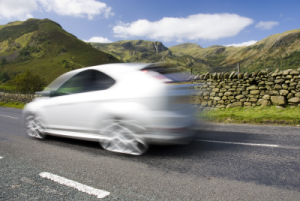
"Open the bonnet, identify where the brake fluid reservoir is and tell me how you would check that you have a safe level of hydraulic brake fluid."
Open the bonnet and show the examiner the brake fluid reservoir.
Explain how to check the level against high/low markings. The level is usually visible without removing the cap from the fluid reservoir. Note: In some vehicles, removing the reservoir cap to check the level with a 'mini' dipstick is necessary. Examiners will generally avoid questions on cars where the cap has to be removed.
"Tell me how you would check that the brake lights are working on this car."
Explain how you can operate the brake pedal and then make use of reflections in windows, garage doors, etc., to check whether the lights are working. Alternatively, you could ask the examiner to check the lights for you while you press the brake pedal.
Note: Some vehicles have a 'bulb failed' warning light. Mention this if it's relevant to your test vehicle.
"Tell me how you’d know if there was a problem with your anti-lock braking system."

A dashboard warning light will illuminate if there is a fault with the anti-lock braking system.
The ABS warning light shows a problem with the anti-lock braking system. You can drive temporarily when this light shows, but you must get the car checked as soon as possible. Without ABS, you risk skidding out of control under harsh braking. In addition, you will be unable to steer around obstructions when braking in an emergency.
"Tell me how you would check that the brakes are working before starting a journey."
Before driving, you should feel resistance when you press the brake pedal (when the car is stationary). The pedal should not feel spongy or slack. Test the brakes by pressing the footbrake pedal gently as soon as the car moves. The car should not pull to one side.
Additional information about the brakes:
It's not a good idea to take the operation of your brakes for granted! And the time to check your brakes is NOT when you are heading towards a wall!
Although modern braking systems are very reliable and cars now have fail-safe 'dual circuit' hydraulic systems for extra safety, problems might still arise that can affect braking efficiency or cause brake failure.
In addition to the operation of brakes, you need to know how to check your brake lights - it is illegal and dangerous to drive with brake lights, or even a single brake light, that is not working.
Get into the habit of regularly checking your brake lights and brakes every time you drive.
There are two checks that you can make (mentioned above). A static brake test and a rolling brake test.
Static brake test:
The static brake test is just a matter of pressing the brake pedal when you get into the car. There should be resistance from the pedal; if there isn't, you probably have a fluid leak and should not drive the vehicle.
Rolling brake test:
Complete your 'rolling brake test' by pressing the brake pedal gently as soon as possible after moving off and while driving slowly. This will reassure you that your brakes are OK before you need them.
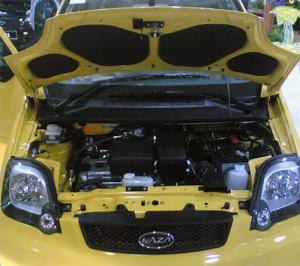
"Open the bonnet and tell me how you’d check that the engine has sufficient oil."
Open the bonnet, identify the dipstick/oil level indicator, and then describe how to check the oil level against the minimum/maximum markers.
"Open the bonnet and tell me how you’d check that the engine has sufficient engine coolant."
Open the bonnet and identify high/low-level markings on the header tank where fitted or radiator filler cap, and describe how to top up to the correct level.
Important: Under no circumstances you be asked to remove the filler cap on the tank or radiator and should not attempt to do so as part of your answer.
Brake fluid: An under-bonnet question about checking the brake fluid level is included in 'brakes' above.
Additional information about 'under the bonnet'
The examiner is unlikely to ask about the following points. However, you should be aware of them.
You must always switch off the engine before opening the bonnet for routine checks. Opening the bonnet with the engine running can present real dangers; for example, a tie or scarf could get caught up in moving parts, causing severe or fatal injury.
You must never remove the lid of the coolant reservoir while the engine is hot. Allow it to cool for at least a couple of hours before topping up. Use an antifreeze mixture should when topping up the coolant- even in summer - as it contains a corrosion inhibitor.
While on the subject of antifreeze - never use engine antifreeze in the screen washer reservoir because it can damage the car's paintwork.
It is essential that you use the appropriate fluids for brake, clutch, steering or coolant reservoirs in your car - also, you should check that any oil you buy is suitable for the vehicle (especially if it's a high-performance or diesel engine). See your car handbook or ask your local mechanic.
Ask your instructor to run through a 'Filling Station Routines' lesson to ensure you know about different fuel types and the colours of fuel pump hoses. Getting the fuel wrong will cause major engine problems (but nothing about £3000 can't cure!).
Windscreen washer fluid: Although not asked about in the test, you should also be able to Identify where the windscreen washer reservoir is and know how to fill it.
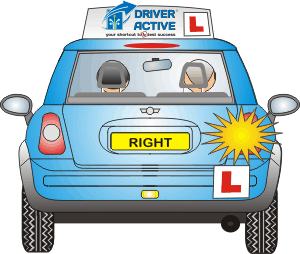
"Tell me how you’d check the direction indicators are working. You don’t need to exit the vehicle."
Explain that you’d operate the indicator or hazard warning light switch (turn on the ignition if necessary) and then walk around the vehicle (as this is a ‘tell me’ question, you don’t need to check the lights physically).
Additional information about indicators:
Although you should know about arm signals in place of (and be able to use them!), if the indicators fail during a driving test, the test will be abandoned (even if you offer to give arm signals).
The test could continue if you can rectify the fault within a few minutes by changing a bulb. Ask your instructor where the spare bulbs are and whether it is easy to change an indicator bulb (some modern vehicles now need special tools to change bulbs).
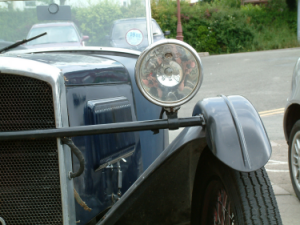
"Tell me how you’d check that the headlights and tail lights are working. You don’t need to exit the vehicle."
Explain that you’d operate the switch (turn on the ignition if necessary), then walk around the vehicle (as this is a ‘tell me’ question, you don’t need to check the lights physically).
"Tell me how you switch your headlight from dipped to main beam and explain how you’d know the main beam is on."
Explain that, with the ignition and headlights switched on, you would operate the dip switch and check for the blue main-beam warning light on the dashboard.
"Tell me how you’d switch on the rear fog lights and explain when you would operate them. You don’t need to exit the vehicle."
Operate the switch (turn on dipped headlights and ignition if necessary). Check that the warning light is on. Explain that you would use fog lights when visibility is below 100 metres. (Legal note: Fog lights must be switched off when visibility improves).
Additional information about lights and reflectors:
Your lights should be clean with all the bulbs working and no cracked or damaged lenses.
The DVSA manual, 'Driving - the essential skills' advises that lights should be checked before and during long journeys and that any lighting fault should be fixed immediately.
All vehicles should carry spare bulbs. If you have a lighting defect, you can be prosecuted, even if you are stopped during the daytime. If you have spare bulbs available, you will probably get away with a warning rather than a penalty ticket.
If your car has a headlight adjuster, you should know what it is for and how and when to use it.
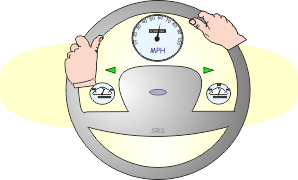
"Explain how you would check that the power assisted steering is working before starting a journey."
Explain the symptoms of power steering loss by stating that the steering becomes heavy. If the steering becomes heavy, the system may not be working correctly.
There are two simple checks you can make to check power steering.
Gentle pressure on the steering wheel, maintained while the engine is started, should result in a slight but noticeable movement of the wheel as the system begins to operate.
Turning the steering wheel just after moving off will give an immediate indication that the power assistance is functioning. If the steering wheel is 'heavy' to turn, there is a problem.
Additional information about steering:
Perhaps it's common sense to ensure that your steering is operating correctly. However, as with all things, it only becomes common sense when you know about it.
Steering failure is rare but would be very dangerous if it occurred while travelling on a busy road. The most common cause of steering failure is the loss of power steering.
Power steering could be lost gradually if a hydraulic pipe is damaged. If this happens, the steering will become heavier. Check the fluid levels. Topping up the steering fluid will offer a temporary fix – but you should consult a mechanic as soon as possible.

"Tell me where you would find the information for the recommended tyre pressures for this car and how tyre pressures should be checked."
Your answer will be something like this:
"I would find the tyre pressures in the car's handbook and then use the tyre inflater at a garage or a tyre pressure gauge to check the pressure when the tyres are cold. I would locate the valve and remove the dust cap. I would then adjust the pressure as necessary using a tyre inflater before refitting the dust caps "
Note: Also mention that you would check the spare tyre.
"Tell me how you would check the tyres to make sure that they have sufficient tread depth and that their general condition is safe to use on the road."
Your answer will be something like this:
"I would use this depth gauge (shows examiner) to check the tread depth in a couple of places across the tyre and make a visible check to ensure the tread is consistent over three-quarters of the width.
I would make a visual check to ensure there are no cuts, blisters or bulges on the tyres. To check the side of the tyre I can't see, I would gently run my hand around, being careful because of the danger of injury from glass or other debris that could be embedded in the tyre.
If I were unsure about any aspect of my tyre safety, I would consult a mechanic".
Note: Also say that you would check the spare tyre.
Additional information about tyres:
Questions relating to tyres make sure that you fully understand the need for tyre maintenance and are to carry out basic tyre checks.
Well-maintained and correctly inflated tyres are perhaps the most critical, user-maintained item on the car.
To answer the questions below, you need to know where information can be found for the vehicle you are using for your driving test. All the questions relate to the vehicle that you use for the test. Your instructor will make sure that you have the information you need.
The examiner will not ask you to inflate the tyres because there are no facilities to do so. Nor should he ask for any demonstration that could be dangerous - for example, running hands around the rim of the tyre. However, you should be able to inflate and check tyres thoroughly, even though these items are not tested in detail.
Statistics from the Department of transport have shown that defective tyres cause 3000 injury accidents every year.
If you do not have a car to learn and practise tyre checks, ask your instructor to cover this in a 'filling station routines' lesson.
Legal information: There must be no cuts and bulges in the tyre wall, 1.6mm of tread depth across the central three-quarters of the breadth of the tyre and around the entire circumference.
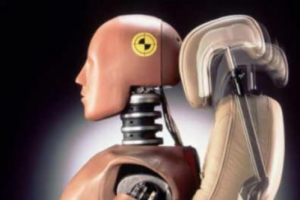
"Tell me how you make sure your head restraint is correctly adjusted so it provides the best protection in the event of a crash."
Adjust your head restraint so the rigid part is at least as high as your eyes or the top of your ears. It should be as close to the back of the head as is comfortable. Note: Some restraints might not be adjustable.
Additional information about head restraints:
Head restraints are designed to protect you in the event of an accident or sudden stop.
When a car stops suddenly, the driver and passengers are thrown forwards - that's why seatbelts are essential. As the seatbelt restrains the body, the head is jerked forwards and then sharply backwards.
When a car is hit from behind, your head will be jerked backwards.
In both of the situations above, the head restraint prevents excessive moving and stretching of the neck and prevents the likelihood of serious injury.
Official DVSA 'Show Me' Video...
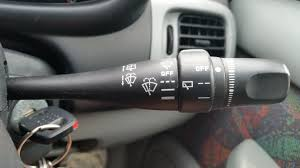 You must be able to operate all of the controls without looking down or being distracted. Make sure you are familiar with all the car controls and practise using them.
You must be able to operate all of the controls without looking down or being distracted. Make sure you are familiar with all the car controls and practise using them.
Having a minor problem with a control when the examiner asks a ‘show me’ question is unlikely to fail the test. But if you make a serious or dangerous driving mistake when operating the controls, perhaps because you have to look away from the road for too long while using it, you will fail.
The examiner will not expect you to operate the control immediately after asking the question. You can do so at the first safe and convenient opportunity.
"When it’s safe to do so, can you show me how you wash and clean the rear windscreen?"
"When it’s safe to do so, can you show me how you wash and clean the front windscreen?"
For these questions, you will need to demonstrate the operation of the front or rear washers and wipers - on most cars, the wipers come on automatically when you activate the washer.
Make sure that you know where the wiper control is and that you can operate it for each function You will generally find this control on a steering column stalk (opposite the indicators),
Of course, if it is raining during your test, you will need to operate the wipers and, if necessary, the washers without being asked or reminded.
"When it's safe to do so, can you show me how you’d switch on your dipped headlights?"
The headlight switch is usually on the same stalk as the indicators. Take care not to confuse other road users when switching on the - this is best done when the road is clear ahead.
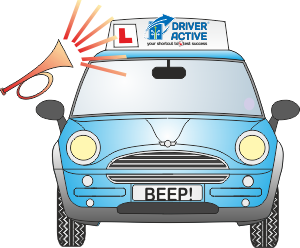
"When it's safe to do so, can you show me how you'd operate the horn?"
Normally, you shouldn't use the horn unless you are warning of danger or alerting another road user to your presence - however, it's OK to demonstrate that you can use it for the driving test.
The horn is often in the centre of the steering wheel but might be on the indicator stalk. Take care not to confuse or startle others when demonstrating the use of the horn - although the examiner will only ask at a safe time, you must double-check.
If you feel it is unsafe to demonstrate the horn or any other control when asked, tell the examiner that you will do it as soon as an opportunity arises - and then remind them just before you do it. (Remember that you don't have to demonstrate the action immediately when the question is asked.)
"When it’s safe to do so, can you show me how you’d set the rear demister?"
"When it’s safe to do so, can you show me how you’d demist the front windscreen?"
The two questions about demisting require operating controls usually located on the centre console. You might need to slow down to demonstrate these controls.
The rear demister an electrically heated rear screen operated by an on/off switch - the front demister is usually part of the cars ventilation system, a fan blows air onto the screen. Some cars also have electrically heated front screens.
Rear demisters will usually switch off automatically; however, you may have to switch off the front demister, especially if it is a noisy fan.
"When it’s safe to do so, can you show me how you’d open and close the side window?"
Virtually all cars now have electric windows, at least in the front. Simply open and close the window.